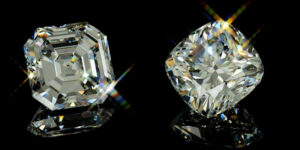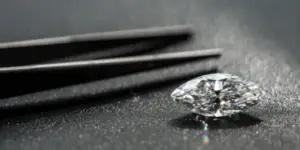Marquise and oval diamonds seem very similar and they share quite a few traits, but when it comes to choosing just one of them, you’ll notice there are quite a few things that are different. Both marquise and ovals tend to slenderize and elongate the finger, and both can be set in an east-west way for a modern twist.
So today’s post will focus on the key differences between oval cuts and marquise cuts so you can make an informed decision. We’ll also talk about the similarities between them and what you should consider when buying either of these diamond cuts.
Please keep in mind that any elongated cut will look different on your finger than it does in the photo. So it’s always a great idea to go and try some different marquise or oval cuts after reading this.
Marquise vs oval diamond
Marquise diamonds have pointed ends while oval diamonds have rounded ones, and this can influence the final ring design. An oval cut is more popular and thus more expensive but can be found in the right cut grade, color, and clarity while a marquise cut offers less options simply because it’s less popular and not carried as much by jewelers.
Oval cut diamonds tend to compliment most people’s fingers while marquises are harder to pull off due to their sharp points and extra length. Those points also need protection because they are weak points for a diamond. A half bezel setting or a prong over each point is recommended for marquise cuts.
Read also: Asscher VS Cushion Cut
What is marquise cut ?
The marquise cut is a brilliant cut style in an elongated shape that ends in a point on either side. It resembles an American football, a small boat, or a pair of lips. In fact legend has it that this cut style surfaced when France’s King Louis XV ordered a diamond to be cut in the shape of his mistress’ lips, the Marquise de Pompadour. Marquise was a rank and noble title between that of a duke and a count.
Today marquise cuts are seen as more of a vintage cut, quite rare, and a look that’s a bit hard to pull off. However a marquise works great as an accent stone if you’re not sure you want it as a center stone, and it’s great in a pair of earrings or in a necklace.
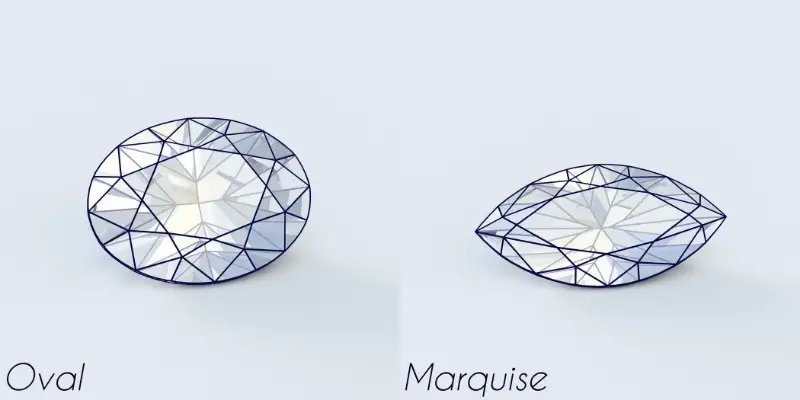
What is oval cut ?
The oval cut is another brilliant cut diamond, like an elongated round cut with points that get progressively smaller but do not have a sharp end like a marquise. Ovals are oval shaped and they can have various ratios and shapes, with wider point or shoulders, depending on what you like better.
Oval cuts are a happy medium between an elongated cut (like the emerald or radiant) and the round brilliant. They generally work for everyone and tend to look quite large for their carat weight. Ovals have a lot of variation in the way they are cut so you will have plenty to choose from.
Now let’s compare the oval and the marquise cut to see their differences but also what you should be mindful of when deciding for one of these.
1. Marquise has pointed ends, ovals are rounded
The key difference between oval cuts and marquise cuts are their ends. Both are elongated shapes with a lot of roundness to their sides, but their ends are vastly different. A marquise ends in sharp points, on either end. Those points add to the charm of a marquise and they’re a defining feature of marquise cuts.
Oval cuts have rounded ends, and their edges don’t form a sharper angle towards the ends. An oval cut’s end is always wider than that of a marquise cut.
That being said, these two diamond cut styles see a lot of variations in their length to width ratios, and also how their ends look. Some have really smooth, flowing lines than lead to the points, and some have sudden, sharp-looking angles leading to the points even if they are ovals.
Read also: Asscher Cut VS Emerald Cut
2. Ovals tend to be wider than marquise cuts
Overall it seems that ovals tend to be wider than marquise cuts, simply because their ends are not as sharp and narrow as a marquise cut. The length to width ratio of a good oval is about 1.35:1 which would suit pretty much all finger shapes and sizes.
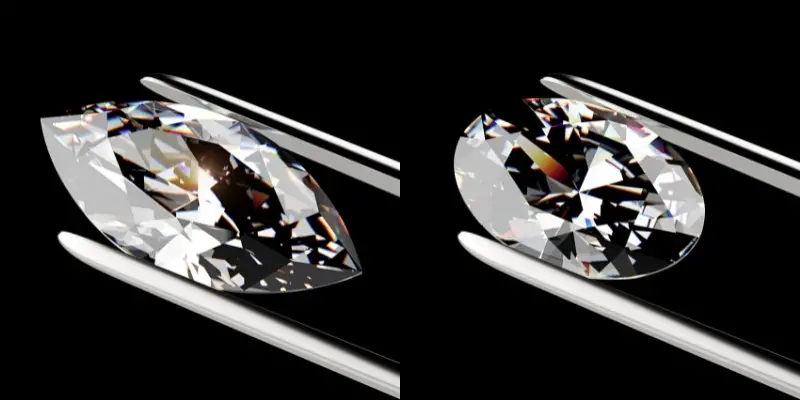
Meanwhile the marquise cut does not have a set standard, so you will often see very skinny marquise cuts or very wide marquise cuts, but they will always look skinnier when compared to an oval cut with a similar ratio.
So if you’re looking for a diamond cut that will definitely compliment your fingers an oval cut is a safer bet than a marquise, simply because it tends to work better for most people.
3. Marquise cuts may be a bit more fragile than ovals
Marquise cuts have two very sharp, pointed ends. In a diamond such a point is in fact something you want to keep safe, as any hit on those ends can fracture a diamond. Remember, a diamond resists scratching and chipping, but can still be broken with the right hit at the right angle and in the right place. Sharp corners are those right places.
This is why you should always cover up your marquise’s points. Some consider that this adds to the beauty of a marquise, some consider it subtracts. In either case, it is much safer to cover a marquise’s points than to leave them uncovered. You can use a V prong or bezel, a full bezel, or even just a simple prong as long as there is something on that point.
Oval cuts are quite safe in that regard. They can survive just fine in a classic prong setting as they have no sharp corners that need protection.
4. Oval cuts are more common and popular than marquise
You will find oval cuts are far more popular and thus carried by more jewelers than marquise cuts. In some cases you might not even find a marquise cut at your local jeweler, if you live in a smaller town.
Oval cuts also tend to be more expensive than marquise cuts because they’re more popular, and have higher standards so there will always be a very good or ideal cut oval but less so for a marquise. That’s just the way the market works.
But, this also means a marquise cut diamond will be unique, certainly more so than an oval. Which leaves you plenty of budget for an interesting band, or side stones, or anything you might want to add to your marquise diamond.
5. Marquise cuts appear larger than oval cuts
Both marquise and ovals appear quite large, and definitely larger than a round cut when you look at carat weight alone. However the marquise tends to look a bit larger than the oval of the same carat weight, due to two things:
- shallower pavilion and crown, thus a generally shallower cut
- the pointed ends tend to look like they take up more space than an oval
Again, both marquise and oval cuts look large for their carat size. but the marquise looks a bit larger. Now let’s take a look at the things you should remember when browsing for a marquise or an oval, because these points matter and they apply to both diamond cuts.
Both marquise and oval tend to show a bow tie effect
Due to the nature of the faceting applied to ovals and marquise cuts you will notice that all of them have a dull or darker area right in the middle of the diamond. It’s s sort of figure 8 going from side to side, where the facets appear much darker or duller and it’s most noticeable when you view the diamond face-up. This is called a bow tie effect.
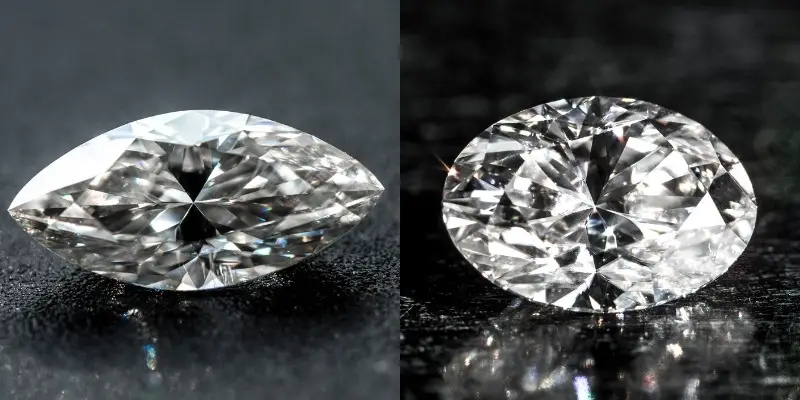
All ovals and marquise diamond do this, it’s simply in their nature, and it’s just because it’s not an even shape (like a round or a square). Some ovals and marquise cuts show more of a bow tie, some show less, but all of them have it. And if you’re wondering yes, a pear shape also has a bow tie.
Be mindful of the ratio for marquise and ovals
The length to width ratio of your oval or marquise can make or break the look. Too skinny a marquise will just seem off, and you will likely feel like it needs some side stones to achieve a fuller look. Conversely too thick or wide a marquise and it tends to look off, like someone didn’t cut an oval quite right.
Whichever ratio you choose, you should also consider your finger size and shape. The diamond should cover part of your finger but it should not leave enough skin as to appear much too small. Play around with the different ratios and see which diamond fits your finger best.
Consider a low setting for marquise and ovals
Worried about marquise and ovals snagging on everything ? That’s is mostly due to the way they are se, in ters of height and whether it’s a prong or a bezel.
So for example a marquise cut diamond will snag if it’s a high setting and it has prongs. Swap the prongs for a half bezel and it won’t snag as much, and if you lower the setting a little, or add some shoulders like for a cathedral setting, you will get a much smoother-looking ring with far less snagging. Oval cuts tend to snag a little less but they too benefit form a lower setting.
If you want to be absolutely sure that our setting will not interfere with your daily life then opt for a bezel or half-bezel and you wil get a smooth, sleek look (as long as it is a thin bezel).

I’m the main author for jewelrymaterialguide.com. I started this site after we did tons of research before our wedding and noticed that there is information about rings, jewelry, and so on that is really hard to find on the internet.


